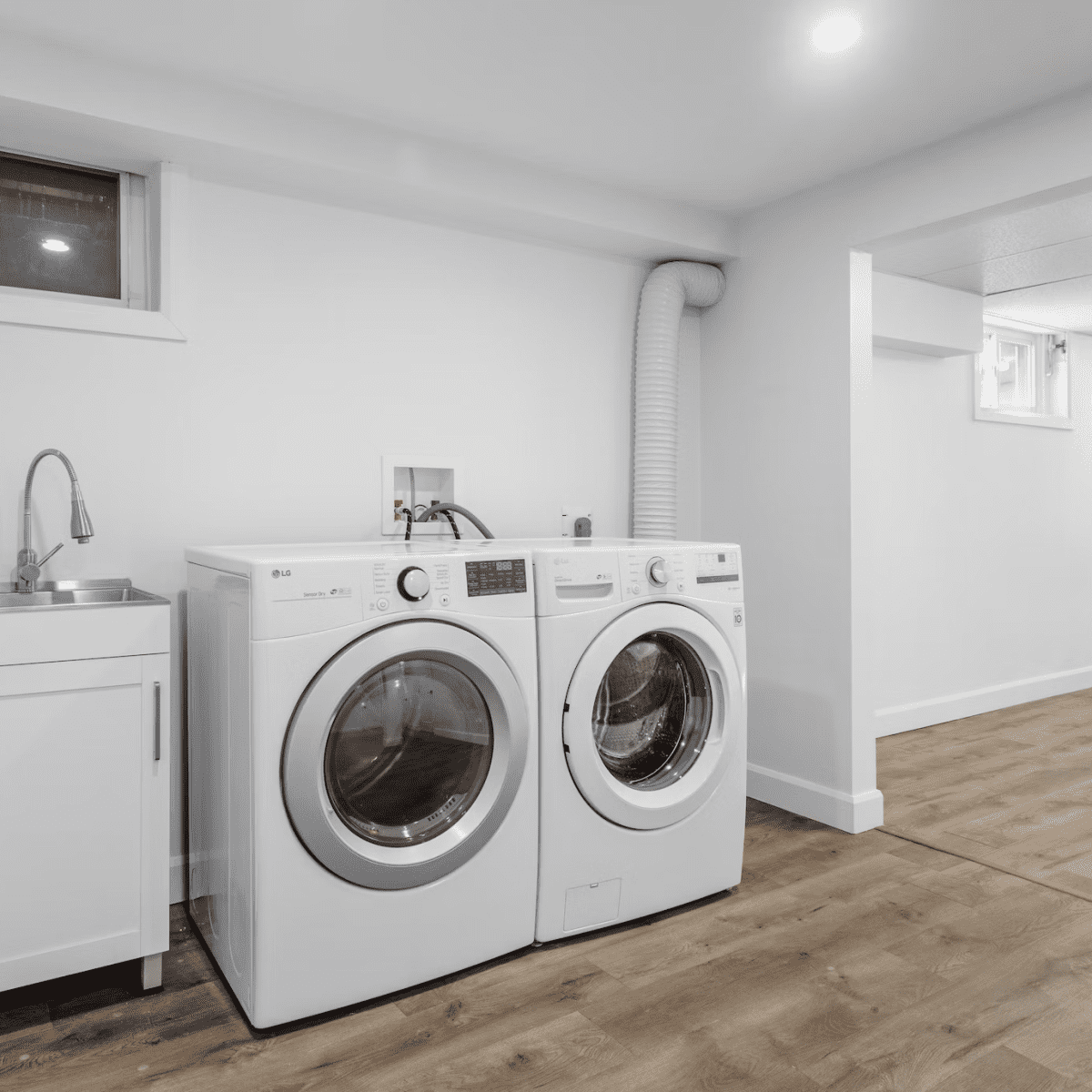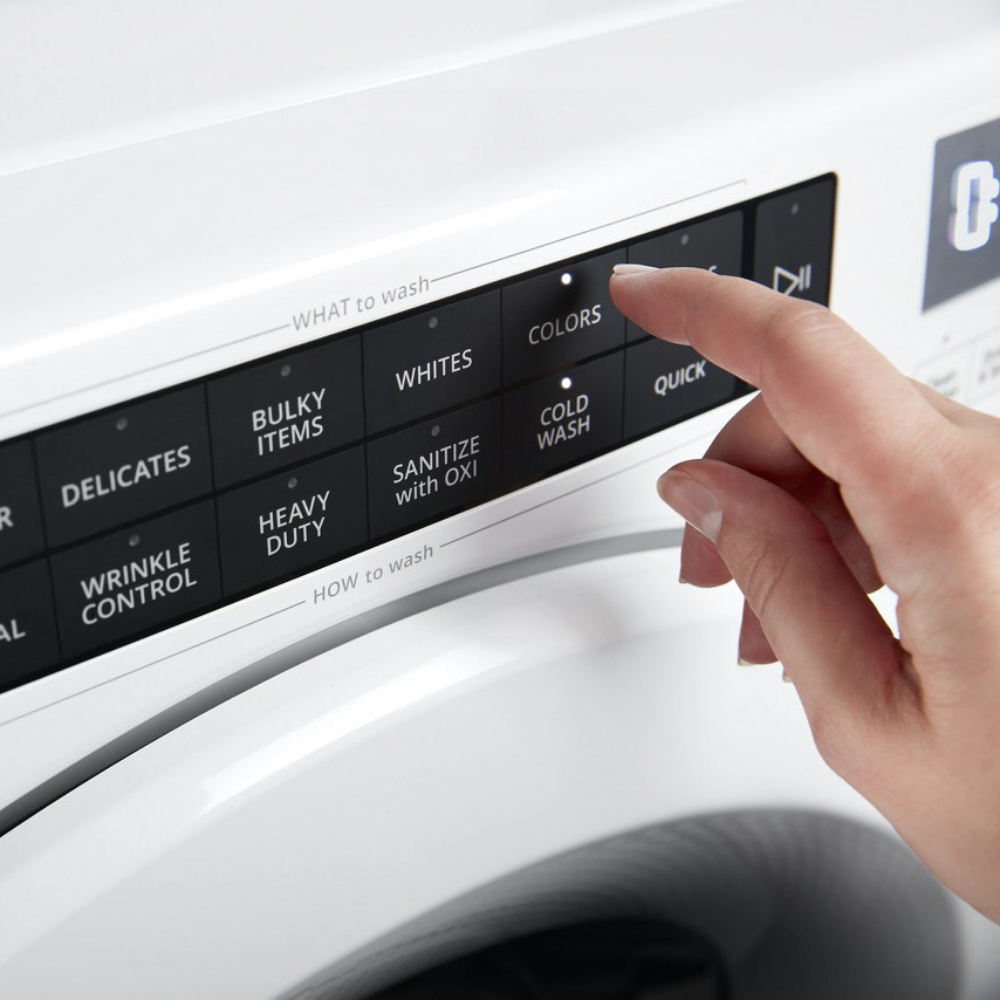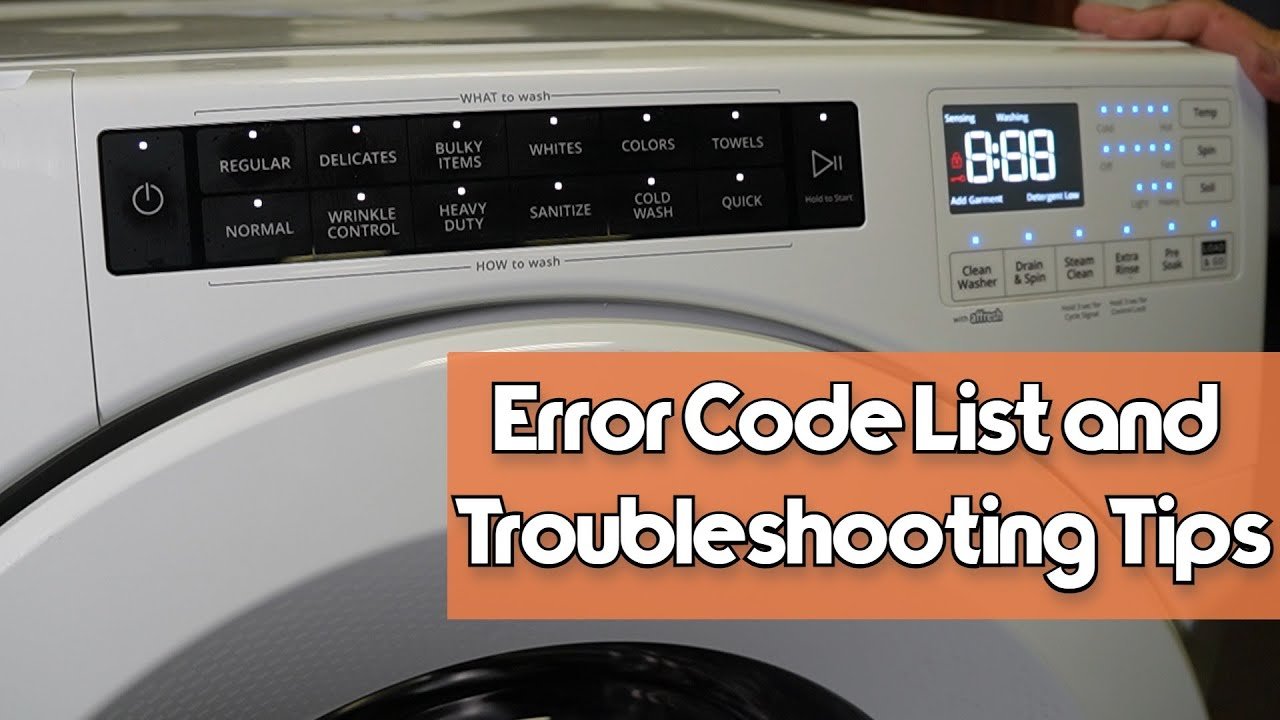Troubleshooting a Whirlpool Front Load Washer often involves checking for power issues and ensuring the door is properly closed. For specific problems, consult the user manual or error codes displayed on the washer.
Embarking on a mission to resolve issues with your Whirlpool Front Load Washer can be a daunting task, but with a systematic approach, it becomes manageable. Home appliances play a pivotal role in our daily routines, and a malfunctioning washer can throw a wrench in your plans.
Understanding common problems such as leaks, noises, or cycle interruptions is the first step to getting your laundry routine back on track. This introduction is designed to guide you through the basics of troubleshooting your machine, offering insights and tips to diagnose and potentially fix the issues at hand. Remember, safety is paramount, so always disconnect power before attempting any repairs. With these guidelines, you’ll be equipped to tackle washer woes with confidence.

Credit: m.youtube.com
Introduction To Whirlpool Front Load Washer Issues
Whirlpool Front Load Washers are popular for their efficiency and reliability. Yet, like any appliance, they can face issues. Understanding these problems is key to keeping your washer running smoothly.
Common Challenges Faced By Users
Users often encounter several issues with their Whirlpool Front Load Washers. These problems can disrupt laundry routines and cause frustration.
- Drainage issues: Water may not drain properly.
- Error codes: The washer displays various error messages.
- Door lock problems: The door might not lock or unlock correctly.
- Noisy operation: The washer makes unusual sounds during cycles.
- Odor problems: A musty smell can develop inside the washer.
Benefits Of Quick Troubleshooting
Addressing issues with your Whirlpool Washer promptly has several benefits.
- Extends appliance life: Fixing problems early can prevent more serious damage.
- Saves money: Avoid costly repairs or replacements by troubleshooting early.
- Improves efficiency: Your washer performs better when it’s in good condition.
- Enhances laundry results: Solve issues for cleaner, fresher clothes.
Identifying Error Codes
Modern Whirlpool front load washers come equipped with digital displays. These displays provide error codes when the washer encounters a problem. Understanding these codes is key to troubleshooting issues. Let’s dive into the common error codes and decipher what they mean for your washer.
Deciphering The Washer’s Digital Messages
Error codes on your Whirlpool washer are clues to the problem. They may indicate issues from a simple door lock malfunction to more complex motor problems. It’s important to identify and understand these codes to resolve issues quickly.
Most Frequent Error Codes And Meanings
| Error Code | Meaning |
|---|---|
| F5 E2 | Door lock error |
| F7 E1 | Motor drive issue |
| F8 E1 | Low water flow detected |
| F9 E1 | Long drain time |
| LC | Control lock activated |
Note: Refer to your washer’s manual for a complete list of error codes. If an issue persists, seek professional help.
Door Lock Malfunctions
Washer door lock issues can halt laundry day in its tracks. Knowing how to troubleshoot can save time and stress. Here’s how to address Whirlpool Front Load Washer door lock malfunctions.
Symptoms Of A Faulty Door Lock
- Washer won’t start cycles
- Door won’t lock or unlock
- Error codes flashing on display
- Unusual noises from door area
Simple Steps To Resolve Door Issues
Check the door for obstructions. Ensure it’s closed properly.
Examine the door seal for foreign objects. Remove any found.
Perform a power reset by unplugging the washer for one minute. Plug back in.
Inspect the door lock for damage. If damaged, professional repair is needed.
Follow these steps for a quick fix to common door lock issues.
Water Inlet Problems
When your Whirlpool Front Load Washer has issues filling up, you might face water inlet problems. This can stop your laundry routine in its tracks. Water inlet issues often stem from valve complications or clogged filters. Proper troubleshooting can help you identify and fix these problems swiftly.
Signs Of Inlet Valve Complications
Several indicators point to a faulty inlet valve. Look for these:
- Washer won’t fill with water
- Water fills slowly
- Washer makes unusual noises during fill
- Water continuously drips into the drum
Checking And Cleaning Water Supply Filters
Filters ensure clean water enters your washer. They can get clogged over time. Follow these steps:
- Turn off the water supply
- Disconnect hoses from the washer
- Remove filters using pliers
- Clean filters with a brush under running water
- Reinsert filters and reconnect hoses
- Turn water supply back on
Regular maintenance keeps your washer running smoothly.
Drainage Dilemmas
Drainage issues in Whirlpool front load washers can lead to poor performance and unpleasant odors. A common culprit for these problems is a clogged drain pump. Understanding how to troubleshoot and maintain your washer’s drainage system ensures efficient operation and extends the life of your appliance.
Troubleshooting A Clogged Drain Pump
Signs of a clogged drain pump include water not draining, the washer not spinning, or an error code on the display. Follow these steps to check for blockages:
- Turn off the washer and unplug it from the power source.
- Remove the front panel to access the drain pump.
- Place a towel and a shallow pan beneath the pump to catch water.
- Open the pump’s filter cover and inspect for debris.
- Clean the filter thoroughly and check the pump impeller.
- Ensure the impeller turns freely without obstructions.
- Reassemble the pump cover and front panel.
- Plug in the washer and run a test cycle to check operation.
Maintenance Tips For Optimal Drainage
Regular maintenance prevents drainage problems and keeps your washer running smoothly. Implement these tips for optimal drainage:
- Check and clean the drain pump filter monthly.
- Avoid overloading the washer to reduce strain on the pump.
- Use the correct amount of detergent to prevent excess suds.
- Run a hot water cycle with vinegar to clear detergent buildup.
- Inspect and clean the drain hose annually for obstructions.
Performing these maintenance steps can prevent future drainage dilemmas and save on costly repairs. Keep your Whirlpool front load washer draining properly with consistent care and troubleshooting.

Credit: dengarden.com
Spin Cycle Irregularities
Dealing with Spin Cycle Irregularities in your Whirlpool Front Load Washer can be frustrating. These issues may cause your clothes to come out wetter than expected. Understanding the common problems and how to fix them is key. Let’s explore solutions for a smoother operation.
Assessing Unbalanced Loads
Unbalanced loads are a common cause of spin cycle issues. They occur when clothes are not evenly distributed inside the drum. This can make the washer shake and stop the spin cycle prematurely. Here are steps to fix this:
- Pause the washer and open the door.
- Redistribute the clothes evenly.
- Close the door and restart the spin cycle.
This simple adjustment can significantly improve the spin cycle’s performance.
Adjusting The Washer For Smooth Operation
Another factor affecting the spin cycle is the washer’s leveling. An uneven washer can lead to irregularities during the spin cycle. Follow these steps to ensure your washer is properly adjusted:
- Check the washer’s level by placing a spirit level on top.
- Adjust the legs by turning them clockwise or counter-clockwise.
- Recheck the level and adjust as needed until the washer is stable.
Ensuring your washer is level and stable can prevent many spin cycle issues.
Detergent Dispenser Glitches
Detergent Dispenser Glitches can halt your laundry day. These problems often stem from a dirty dispenser or using the wrong detergent type. Understanding how to tackle these issues ensures your Whirlpool Front Load Washer runs smoothly.
Cleaning The Dispenser Drawers
Cleaning the dispenser drawers is simple but vital. Here’s how:
- Remove the drawers gently.
- Use warm, soapy water to clean them.
- For tough residue, use a soft brush.
- Rinse thoroughly with clean water.
- Dry and replace the drawers back into the washer.
This process should happen monthly to prevent buildup and ensure optimal performance.
Proper Detergent Use And Tips
Choosing and using detergent correctly is crucial for your washer.
- Use HE (High Efficiency) detergent to avoid excess suds.
- Measure accurately. Too much detergent can leave residue.
- Liquid versus powder: Use the recommended type for your model.
- Single-dose pods go in the drum, not the dispenser.
Following these tips will prevent dispenser glitches and keep clothes clean.
Odor And Mold Prevention
Fresh clothes start with a clean washer. A Whirlpool front load washer must stay odor-free. Mold and mildew can spoil this. Preventing these issues is key. Let’s explore how to keep your washer clean and fresh.
Routine Cleaning Recommendations
Regular maintenance avoids odor and mold. Here’s a simple routine:
- Monthly Clean Cycle: Run with washer cleaner.
- Wipe Gasket: Use a damp cloth after each use.
- Leave Door Open: Lets air circulate, drying out moisture.
- Remove Clothes Promptly: Prevents damp smells.
- Use Correct Detergent: High-efficiency (HE) type is a must.
Avoiding Common Hygiene Mistakes
Small changes make a big difference. Avoid these:
| Common Mistake | Prevention Tip |
|---|---|
| Excess Detergent | Measure carefully. Too much causes residue. |
| Closed Washer Door | Keep it open post-wash. Stops mildew growth. |
| Wet Gasket | Dry the seal. Stops mold from forming. |
| Ignored Clean Cycle | Run monthly. Keeps the drum fresh. |
Professional Help Or Self-repair
Deciding between professional help and self-repair is crucial. Whirlpool front load washers might need attention. Know when to call a technician or tackle the issue yourself.
When To Call A Technician
- Complex Issues: Call for errors beyond basic troubleshooting.
- Warranty Concerns: DIY may void warranties.
- Safety Risks: Electrical and water risks need experts.
- Repeated Problems: Persistent issues require professional assessment.
Resources For Diy Washer Repair
For those keen on DIY repair, resources are available. Start with the Whirlpool user manual for guidance.
- Check Whirlpool’s official website for support and FAQs.
- Visit forums and DIY repair communities for shared experiences.
- Watch how-to videos for step-by-step instructions.
- Read repair blogs and appliance repair guides.
Ensure you have the right tools. Verify power and water supplies are off before starting.

Credit: www.homedepot.com
Conclusion: Ensuring Longevity
Maintaining a Whirlpool front load washer is key to its longevity. This section provides essential steps and benefits to keep your washer running smoothly.
Summary Of Troubleshooting Steps
- Check the power source and circuit breaker.
- Inspect the door seal and clean it regularly.
- Examine hoses for kinks or leaks.
- Run a cleaning cycle monthly.
- Contact customer support for unresolved issues.
Benefits Of Regular Maintenance
| Maintenance Task | Benefit |
|---|---|
| Cleaning the filter | Prevents clogs and ensures efficiency |
| Inspecting the drum | Reduces noise and maintains performance |
| Checking water inlet | Ensures proper water flow |
| Using correct detergent | Protects from excess suds and machine damage |
Frequently Asked Questions
What Is The Most Common Problem With Whirlpool Washer Front?
The most common issue with Whirlpool front-load washers is the failure of the door seal, leading to water leaks and dampness.
How To Reset Front Load Whirlpool Washer?
To reset a front-load Whirlpool washer, unplug it for 30 seconds, then plug it back in. Press and hold the ‘Start’ button for a few seconds to restart the cycle.
What Is The Most Common Problem With Front Load Washer?
The most common problem with front load washers is the buildup of mold and mildew around the door seal, causing odors.
Why Won’t My Whirlpool Front Load Washer Start But Has Power?
A Whirlpool front load washer may not start due to a tripped circuit breaker, a faulty door lock, or an activated control lock feature. Check and reset breakers, ensure the door is securely closed, and deactivate the control lock if necessary.
Conclusion
Tackling issues with your Whirlpool front load washer doesn’t have to be daunting. Armed with the troubleshooting tips from our guide, you’re now equipped to address common snags swiftly. Remember, regular maintenance can prevent many problems before they arise. For persistent or complex faults, seeking professional help is wise.
Keep your washer running smoothly and your laundry days stress-free.

